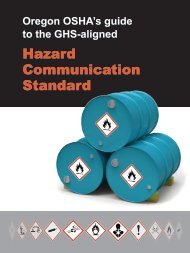Technical Manual - Section 3 (Safety Hazards)
Technical Manual - Section 3 (Safety Hazards)
Technical Manual - Section 3 (Safety Hazards)
You also want an ePaper? Increase the reach of your titles
YUMPU automatically turns print PDFs into web optimized ePapers that Google loves.
Figure III:2-8 Atmospheric Distillation<br />
VACUUM DISTILLATION TOWER<br />
In order further to distill the residuum or topped crude from<br />
the atmospheric tower at higher temperatures, reduced<br />
pressure is required to prevent thermal cracking. The process<br />
takes place in one or more vacuum distillation towers. The<br />
principles of vacuum distillation resemble those of fractional<br />
distillation and, except that larger-diameter columns are used<br />
to maintain comparable vapor velocities at the reduced<br />
pressures, the equipment is also similar. The internal designs<br />
of some vacuum towers are different from atmospheric towers<br />
in that random packing and demister pads are used instead of<br />
trays. A typical first-phase vacuum tower may produce gas<br />
oils, lubricating-oil base stocks, and heavy residual for<br />
propane deasphalting. A second-phase tower operating at<br />
lower vacuum may distill surplus residuum from the<br />
atmospheric tower, which is not used for lube-stock<br />
processing, and surplus residuum from the first vacuum tower<br />
not used for deasphalting. Vacuum towers are typically used<br />
to separate catalytic cracking feedstocks from surplus<br />
residuum.<br />
OTHER DISTILLATION TOWERS (COLUMNS)<br />
Within refineries there are numerous other, smaller<br />
distillation towers called columns, designed to separate<br />
specific and unique products. Columns all work on the same<br />
principles as the towers described above. For example, a<br />
depropanizer is a small column designed to separate propane<br />
and lighter gases from butane and heavier components.<br />
Another larger column is used to separate ethyl benzene and<br />
xylene. Small "bubble" towers called strippers use steam to<br />
remove trace amounts of light products from heavier product<br />
streams.<br />
HEALTH AND SAFETY CONSIDERATIONS<br />
Fire Prevention and Protection<br />
III:2-18
















